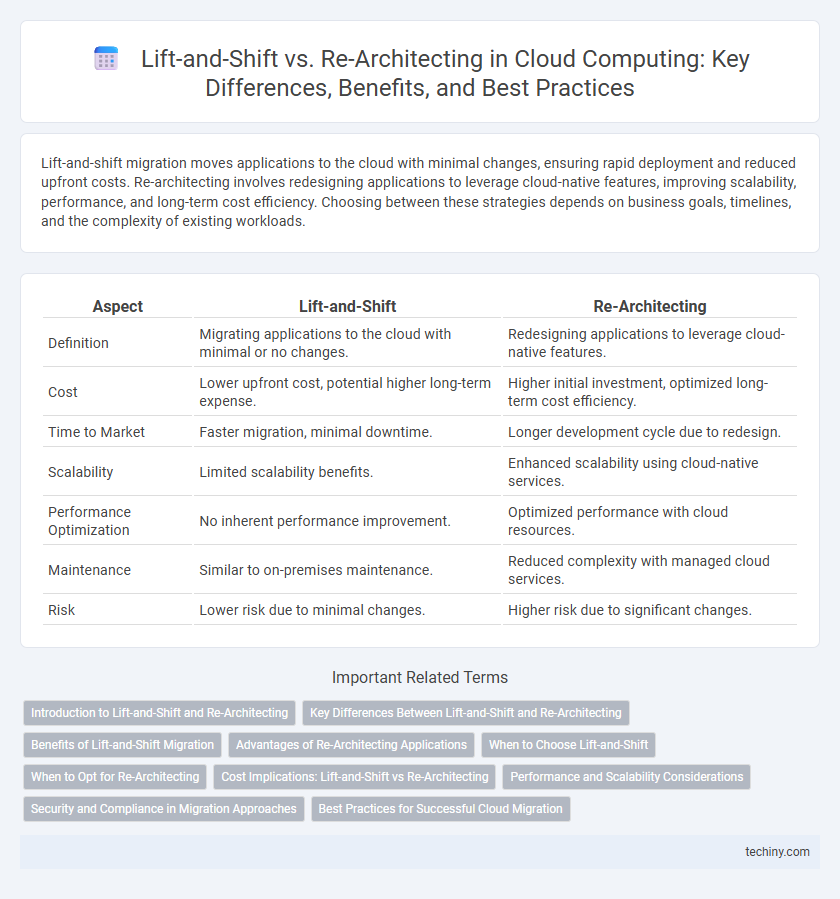Lift-and-shift migration moves applications to the cloud with minimal changes, ensuring rapid deployment and reduced upfront costs. Re-architecting involves redesigning applications to leverage cloud-native features, improving scalability, performance, and long-term cost efficiency. Choosing between these strategies depends on business goals, timelines, and the complexity of existing workloads.
Table of Comparison
| Aspect | Lift-and-Shift | Re-Architecting |
|---|---|---|
| Definition | Migrating applications to the cloud with minimal or no changes. | Redesigning applications to leverage cloud-native features. |
| Cost | Lower upfront cost, potential higher long-term expense. | Higher initial investment, optimized long-term cost efficiency. |
| Time to Market | Faster migration, minimal downtime. | Longer development cycle due to redesign. |
| Scalability | Limited scalability benefits. | Enhanced scalability using cloud-native services. |
| Performance Optimization | No inherent performance improvement. | Optimized performance with cloud resources. |
| Maintenance | Similar to on-premises maintenance. | Reduced complexity with managed cloud services. |
| Risk | Lower risk due to minimal changes. | Higher risk due to significant changes. |
Introduction to Lift-and-Shift and Re-Architecting
Lift-and-shift involves migrating applications to the cloud without modifying their architecture, enabling faster deployment and reduced initial costs. Re-architecting entails redesigning applications to leverage cloud-native features, improving scalability, performance, and cost efficiency over time. Understanding the differences between lift-and-shift and re-architecting is crucial for aligning cloud migration strategies with business objectives.
Key Differences Between Lift-and-Shift and Re-Architecting
Lift-and-shift migrates existing applications to the cloud with minimal changes, prioritizing speed and cost-efficiency but often sacrificing cloud-native benefits like scalability and resilience. Re-architecting involves redesigning applications to leverage cloud services fully, enhancing performance, agility, and scalability but requiring more time and resources upfront. The key differences lie in the migration complexity, long-term cost implications, and ability to optimize applications for cloud ecosystems using services like AWS Lambda, Azure Functions, or Google Cloud Pub/Sub.
Benefits of Lift-and-Shift Migration
Lift-and-shift migration accelerates cloud adoption by moving applications to the cloud with minimal changes, significantly reducing initial migration time and costs. It preserves existing architectures, enabling businesses to maintain operational continuity while benefiting from cloud scalability and cost-efficiency. This approach simplifies migration complexity, making it ideal for legacy systems needing rapid cloud integration without immediate refactoring.
Advantages of Re-Architecting Applications
Re-Architecting applications in cloud computing maximizes scalability and performance by leveraging native cloud services and microservices architecture. It enables enhanced flexibility, improved fault tolerance, and cost efficiency through optimized resource utilization and automated management. This approach supports future-proof innovation and seamless integration with modern DevOps pipelines and continuous delivery practices.
When to Choose Lift-and-Shift
Lift-and-shift migration is ideal when organizations need to quickly move legacy applications to the cloud without extensive code changes, minimizing upfront costs and reducing downtime. This approach suits applications with stable architectures that require immediate cloud benefits like scalability and disaster recovery. Enterprises often choose lift-and-shift for legacy systems that are not cloud-native but must be modernized rapidly to leverage cloud infrastructure.
When to Opt for Re-Architecting
Re-architecting is ideal when applications require cloud-native features such as scalability, resilience, and optimized performance that lift-and-shift cannot provide. This approach is necessary for legacy systems that impede innovation or generate high operational costs if migrated without modification. Enterprises aiming to leverage serverless computing, microservices, or containerization benefit significantly from re-architecting their applications.
Cost Implications: Lift-and-Shift vs Re-Architecting
Lift-and-shift migration typically involves lower upfront costs due to minimal application changes, making it a faster and less expensive option initially. Re-architecting requires higher investment as applications are redesigned to leverage cloud-native services, which can lead to greater long-term cost savings through improved efficiency and scalability. Organizations must balance immediate migration expenses with potential operational cost reductions when choosing between lift-and-shift and re-architecting strategies.
Performance and Scalability Considerations
Lift-and-shift migration involves moving applications to the cloud with minimal changes, often resulting in limited performance gains and scalability improvements due to legacy architecture constraints. Re-architecting optimizes applications for cloud-native features like auto-scaling, microservices, and distributed databases, significantly enhancing performance and scalability. Organizations must weigh immediate cost savings of lift-and-shift against long-term benefits of improved cloud resource utilization and system responsiveness offered by re-architecting.
Security and Compliance in Migration Approaches
Lift-and-shift migration moves applications to the cloud with minimal changes, often preserving existing security configurations but potentially inheriting on-premises vulnerabilities and compliance gaps. Re-architecting allows organizations to redesign applications for cloud-native security features, enhancing data protection, identity management, and compliance alignment with standards like GDPR and HIPAA. Choosing re-architecting supports stronger security posture and regulatory adherence by integrating automated monitoring, encryption, and access controls embedded within cloud services.
Best Practices for Successful Cloud Migration
Successful cloud migration relies on selecting the right approach between lift-and-shift and re-architecting based on application complexity and business goals. Lift-and-shift offers a faster transition by moving applications with minimal changes, ideal for legacy systems, while re-architecting optimizes cloud benefits by redesigning applications to leverage cloud-native features such as auto-scaling and microservices. Thorough assessment, testing, and automation of deployment workflows are best practices that ensure minimal downtime and enhanced performance during migration.
Lift-and-Shift vs Re-Architecting Infographic

 techiny.com
techiny.com